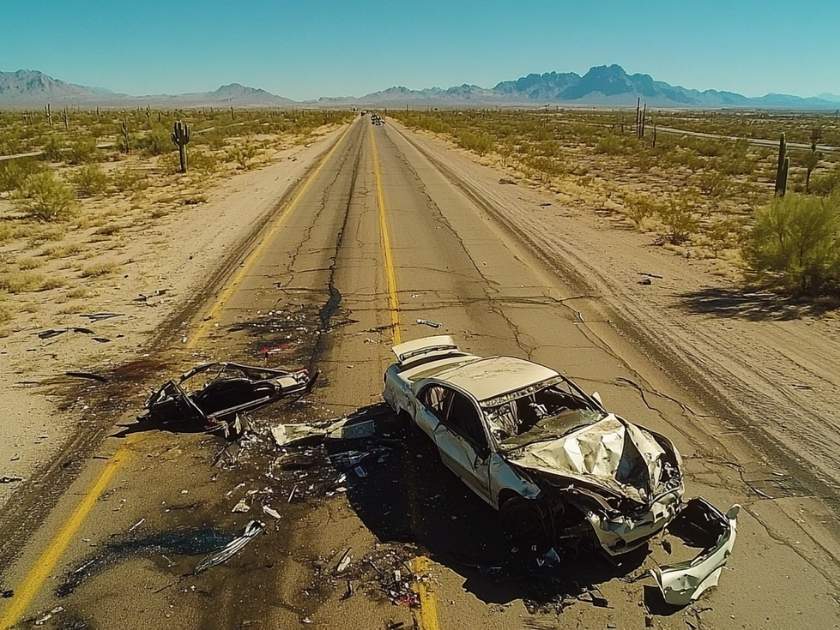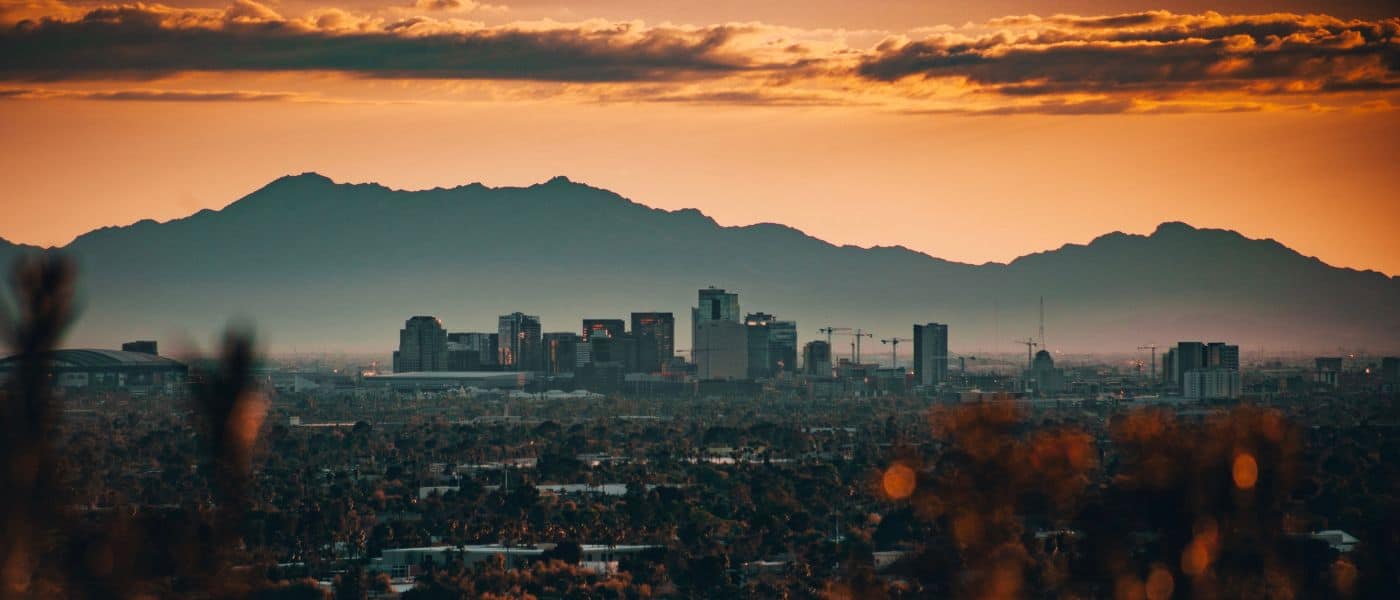Frequency of Car Accidents in Arizona: A Daily Overview
Key Takeaways
- Car accident rates in Arizona vary based on demographics and location
- Weather conditions and road types influence crash frequency
- Driver behavior, including substance use, plays a role in accident occurrence

Car accidents are a significant concern in Arizona, affecting many lives each year. The state’s unique geography, weather patterns, and driving behaviors all play a role in crash frequency. Understanding these factors is crucial for improving road safety.
Motor vehicle crashes in Arizona vary by race and ethnicity, with some groups facing higher risks on the road. This information helps target safety efforts where they’re needed most. Factors like age, gender, and location also influence accident rates across the state.
Arizona’s roads face unique challenges. The state’s mix of urban and rural areas, along with extreme weather conditions, can increase crash risks. Severe winds and other weather events impact crash frequency, especially on interstate freeways. Driver behavior, including alcohol and marijuana use, also contributes to accidents.

Magnitude of Car Accidents in Arizona
Arizona faces a significant number of car accidents each year. The state’s roads see many motor vehicle crashes that impact drivers, passengers, and pedestrians.
In recent years, Arizona has reported tens of thousands of traffic accidents annually. These incidents range from minor fender-benders to serious collisions with injuries or fatalities.
The Arizona Department of Transportation collects data on vehicle accidents across the state. This information helps identify trends and problem areas.
Factors affecting crash frequency include:
- Weather conditions
- Road design
- Driver behavior
- Vehicle type
Interstate freeways in Arizona see a notable portion of these accidents. Researchers have studied how different variables impact crash rates on these highways.
The magnitude of car accidents varies by location within Arizona. Urban areas like Phoenix typically experience more vehicle collisions due to higher traffic volumes.
Rural roads also present risks, often due to higher speeds and less frequent maintenance. The severity of crashes can differ between urban and rural settings.

Demographics of Car Accident Victims
Car accidents in Arizona affect people of all ages and backgrounds. Certain groups face higher risks of fatal crashes and serious injuries. Understanding these patterns can help improve road safety for everyone.
Fatal Accidents and Their Impacts
In Arizona, motor vehicle crash fatalities vary by race and ethnicity. Native Americans have the highest death rates in traffic accidents. Young adults and elderly drivers are also at greater risk of fatal crashes.
Men are more likely to die in car accidents than women. This gender gap is especially wide for motorcycle crashes.
Rural areas see more fatal accidents per capita than cities. Maricopa County, which includes Phoenix, has fewer deaths relative to its population.
Alcohol plays a big role in deadly crashes. Many victims are either impaired drivers or innocent people hit by drunk drivers.
Non-Fatal Injuries
Most car accident victims survive, but many face lasting impacts. Whiplash, broken bones, and head trauma are common.
Pedestrians hit by cars often suffer severe injuries. They lack the protection of a vehicle frame. Children and older adults are at higher risk as pedestrians.
Motorcyclists frequently sustain serious injuries in crashes. Many riders experience head trauma, even with helmets.
Rear-end collisions cause many neck and back injuries. These can lead to chronic pain for victims.
Freeway management systems have helped reduce crash rates and injuries in the Phoenix metro area. But with population growth, the total number of people hurt in crashes remains high.

Geographic Factors Influencing Accidents
Arizona’s diverse geography plays a big role in car accident patterns. The state’s mix of urban and rural areas creates different risks for drivers. Certain locations also stand out as accident hotspots.
Rural Versus Urban Collision Rates
Rural areas in Arizona have higher fatal crash rates than cities. This is due to faster speeds on open roads and longer emergency response times. Rural drivers also face risks from wildlife crossings and unfamiliar roads.
Urban areas like Phoenix see more crashes overall, but they tend to be less deadly. Heavy traffic in cities leads to many fender-benders. Intersections are danger zones for urban drivers.
Maricopa County, which includes Phoenix, has the most accidents in Arizona. This is because it has the largest population. But its crash rate per capita is lower than some rural counties.
Hotspots for Accidents in Arizona
Some areas in Arizona have more crashes than others. These hotspots include:
- I-10 between Phoenix and Tucson
- I-17 north of Phoenix
- Loop 101 in the Phoenix metro area
Mountain roads can be risky, especially in winter. Sedona’s winding routes see many crashes. The Grand Canyon area has hazards from wildlife and tourist traffic.
Border areas face unique risks. Heavy truck traffic and driver fatigue contribute to accidents near Mexico. Weather also plays a role. Dust storms in southern Arizona can cause multi-car pileups.

Behavioral Causes of Accidents
Driver behavior plays a big role in car crashes. Key factors include alcohol use, distractions, and risky driving habits. These actions can lead to serious accidents on Arizona roads.
Driving Under the Influence
Alcohol impairs judgment and slows reaction times. In Arizona, drunk driving causes many fatal crashes. Even small amounts of alcohol can affect driving skills.
Blood alcohol levels over 0.08% are illegal. But lower levels still increase crash risk. Drunk drivers may:
- Swerve between lanes
- Drive too fast or slow
- React slowly to traffic signals
- Have trouble judging distances
Penalties for DUI in Arizona are strict. They include fines, license suspension, and jail time. Repeat offenders face harsher punishments.
Distractions Behind the Wheel
Distracted driving is a top cause of crashes. Common distractions include:
- Texting or talking on cell phones
- Eating or drinking
- Adjusting the radio or GPS
- Talking to passengers
Texting is especially risky. It takes eyes off the road for about 5 seconds. At 55 mph, that’s like driving the length of a football field blindfolded.
Arizona bans texting while driving. Hands-free phone use is allowed. But even this can be distracting. The safest choice is to avoid phone use entirely while driving.
Speeding and Aggression
Speeding raises crash risk and makes accidents more severe. Aggressive driving behaviors also cause many crashes. These include:
- Tailgating
- Cutting off other cars
- Running red lights
- Weaving through traffic
Speeding gives drivers less time to react. It also increases stopping distance. At higher speeds, crashes are more likely to cause serious injury or death.
Aggressive drivers often make risky moves. They may change lanes without signaling or pass on the right. This unpredictable behavior puts everyone at risk.

Environmental and Weather-Related Factors
Arizona’s unique climate plays a big role in car crashes. The state sees many weather-related accidents each year.
Hot temperatures can make roads dangerous. Tires may blow out more easily in the heat. Drivers might also get tired faster, leading to more crashes.
Dust storms are another hazard in Arizona. These can pop up quickly and cut visibility to near zero. Drivers caught in dust storms face a high risk of accidents.
While rare, rain can also cause problems. Arizona’s dry climate means roads get slippery when it does rain. Oil buildup on roads makes them extra slick.
Flash floods pose dangers too. These can wash out roads or sweep away cars. Drivers need to be extra careful during monsoon season.
Here’s a list of top weather risks for Arizona drivers:
- Extreme heat
- Dust storms
- Sudden rainstorms
- Flash floods
Studies show that Arizona has fewer weather-related fatal crashes than many states. But the unique risks still need attention.
Drivers should check weather reports before trips. Being ready for sudden changes can help prevent accidents.

Impact of Car Accidents on Arizona’s Road Safety Policies
Car crashes in Arizona have pushed the state to take action. The Arizona Department of Transportation plays a key role in shaping road safety rules.
These accidents have led to new laws and programs. The state now focuses on:
- Drunk driving prevention
- Seat belt use
- Teen driver education
- Distracted driving awareness
Arizona has also improved its roads and highways. This includes better signs, wider lanes, and safer intersections.
The state tracks crash data closely. This helps them spot trends and problem areas. They use this info to make smart choices about where to focus their efforts.
Rural areas have gotten special attention. These places often see more deadly crashes. Arizona has worked to make country roads safer.
The state also runs public awareness campaigns. These teach drivers about risks and safe habits. They aim to change how people think about road safety.
Arizona’s policies now look at many factors that cause crashes. This includes things like:
- Road design
- Weather conditions
- Driver behavior
- Vehicle safety features
By tackling these issues, Arizona hopes to cut down on car accidents and save lives.

Types of Car Accidents
Arizona roads see many kinds of crashes each year. The type of accident often affects how bad injuries are. Some crashes happen more often than others.
Motorcycle and Bicycle Accidents
Motorcycle crashes are common in Arizona. Riders have less protection than car drivers. This leads to worse injuries. Bike crashes also happen a lot. Cyclists share roads with cars, which can be risky.
Both types of accidents often happen at crossroads. Drivers may not see bikes or motorcycles coming. Busy streets in cities like Phoenix see more of these crashes. Rural roads can be dangerous too. Less traffic means drivers may not expect to see bikes.
Safety gear is key for both groups. Helmets save lives in crashes. Bright clothes help drivers spot riders. Bike lanes can cut down on accidents in cities.
Alcohol-Related Fatalities
Drunk driving causes many fatal accidents in Arizona. These crashes often happen at night or on weekends. They can involve single cars or multiple vehicles.
Alcohol slows reaction times. It also affects judgment. This makes crashes more likely and often more severe. Many of these accidents happen on highways. But they also occur on local roads.
Arizona has strict laws against drunk driving. Police set up checkpoints to catch impaired drivers. Still, alcohol-related crashes remain a big problem. They cause many deaths each year. Education programs try to prevent these accidents.
Understanding the complexities surrounding car accidents in Arizona is essential for fostering safer roadways and reducing the tragic toll these incidents take on lives. The interplay of demographic factors, environmental conditions, and driver behavior highlights the multifaceted nature of this issue. As Arizona continues to address these challenges through improved policies, public awareness campaigns, and infrastructure enhancements, it is crucial for all road users to remain vigilant and responsible. By prioritizing safety and making informed decisions behind the wheel, we can collectively work towards a future where accidents are minimized, and every journey is a safe one.



